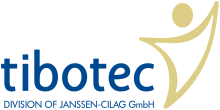 | |
| Industry | Pharmaceutical |
|---|---|
| Founded | 1994 |
| Founders |
|
| Defunct | 2002 |
| Fate | Acquired by Johnson & Johnson and merged into its Janssen Pharmaceuticals division |
| Website | tibotec |
Tibotec was a pharmaceutical company with a focus on research and development of the treatment of infectious diseases such as HIV/AIDS and hepatitis C. The company was founded in 1994 and then acquired by Johnson & Johnson and merged into its Janssen Pharmaceuticals division in 2002. The company is part of Johnson & Johnson Innovation Medicine business segment.
Contents
The name of the company is derived from the tetrahydro-imidazo[4,5,1-jk][1,4]-benzodiazepine-2(1H)-one and -thione (TIBO) compounds discovered at the Rega Institute for Medical Research (Belgium). [1]